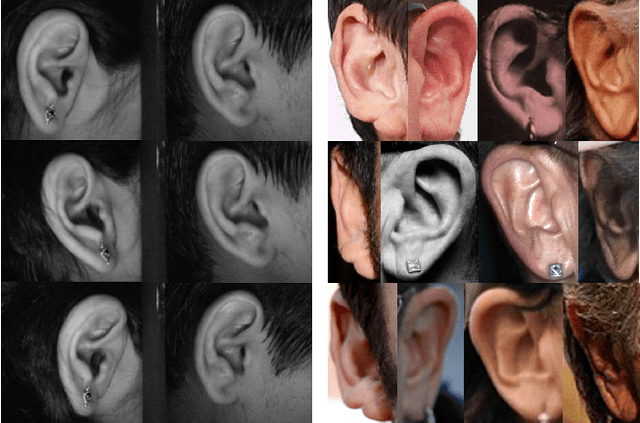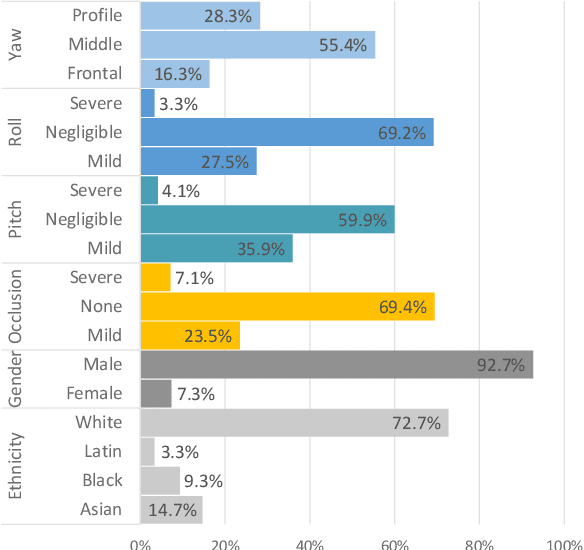Weronika Gutfeter
KVC-onGoing: Keystroke Verification Challenge
Dec 29, 2024



Abstract:This article presents the Keystroke Verification Challenge - onGoing (KVC-onGoing), on which researchers can easily benchmark their systems in a common platform using large-scale public databases, the Aalto University Keystroke databases, and a standard experimental protocol. The keystroke data consist of tweet-long sequences of variable transcript text from over 185,000 subjects, acquired through desktop and mobile keyboards simulating real-life conditions. The results on the evaluation set of KVC-onGoing have proved the high discriminative power of keystroke dynamics, reaching values as low as 3.33% of Equal Error Rate (EER) and 11.96% of False Non-Match Rate (FNMR) @1% False Match Rate (FMR) in the desktop scenario, and 3.61% of EER and 17.44% of FNMR @1% at FMR in the mobile scenario, significantly improving previous state-of-the-art results. Concerning demographic fairness, the analyzed scores reflect the subjects' age and gender to various extents, not negligible in a few cases. The framework runs on CodaLab.
Detecting sexually explicit content in the context of the child sexual abuse materials (CSAM): end-to-end classifiers and region-based networks
Jun 20, 2024Abstract:Child sexual abuse materials (CSAM) pose a significant threat to the safety and well-being of children worldwide. Detecting and preventing the distribution of such materials is a critical task for law enforcement agencies and technology companies. As content moderation is often manual, developing an automated detection system can help reduce human reviewers' exposure to potentially harmful images and accelerate the process of counteracting. This study presents methods for classifying sexually explicit content, which plays a crucial role in the automated CSAM detection system. Several approaches are explored to solve the task: an end-to-end classifier, a classifier with person detection and a private body parts detector. All proposed methods are tested on the images obtained from the online tool for reporting illicit content. Due to legal constraints, access to the data is limited, and all algorithms are executed remotely on the isolated server. The end-to-end classifier yields the most promising results, with an accuracy of 90.17%, after augmenting the training set with the additional neutral samples and adult pornography. While detection-based methods may not achieve higher accuracy rates and cannot serve as a final classifier on their own, their inclusion in the system can be beneficial. Human body-oriented approaches generate results that are easier to interpret, and obtaining more interpretable results is essential when analyzing models that are trained without direct access to data.
IEEE BigData 2023 Keystroke Verification Challenge (KVC)
Jan 29, 2024Abstract:This paper describes the results of the IEEE BigData 2023 Keystroke Verification Challenge (KVC), that considers the biometric verification performance of Keystroke Dynamics (KD), captured as tweet-long sequences of variable transcript text from over 185,000 subjects. The data are obtained from two of the largest public databases of KD up to date, the Aalto Desktop and Mobile Keystroke Databases, guaranteeing a minimum amount of data per subject, age and gender annotations, absence of corrupted data, and avoiding excessively unbalanced subject distributions with respect to the considered demographic attributes. Several neural architectures were proposed by the participants, leading to global Equal Error Rates (EERs) as low as 3.33% and 3.61% achieved by the best team respectively in the desktop and mobile scenario, outperforming the current state of the art biometric verification performance for KD. Hosted on CodaLab, the KVC will be made ongoing to represent a useful tool for the research community to compare different approaches under the same experimental conditions and to deepen the knowledge of the field.
The Unconstrained Ear Recognition Challenge 2019 - ArXiv Version With Appendix
Mar 14, 2019



Abstract:This paper presents a summary of the 2019 Unconstrained Ear Recognition Challenge (UERC), the second in a series of group benchmarking efforts centered around the problem of person recognition from ear images captured in uncontrolled settings. The goal of the challenge is to assess the performance of existing ear recognition techniques on a challenging large-scale ear dataset and to analyze performance of the technology from various viewpoints, such as generalization abilities to unseen data characteristics, sensitivity to rotations, occlusions and image resolution and performance bias on sub-groups of subjects, selected based on demographic criteria, i.e. gender and ethnicity. Research groups from 12 institutions entered the competition and submitted a total of 13 recognition approaches ranging from descriptor-based methods to deep-learning models. The majority of submissions focused on ensemble based methods combining either representations from multiple deep models or hand-crafted with learned image descriptors. Our analysis shows that methods incorporating deep learning models clearly outperform techniques relying solely on hand-crafted descriptors, even though both groups of techniques exhibit similar behaviour when it comes to robustness to various covariates, such presence of occlusions, changes in (head) pose, or variability in image resolution. The results of the challenge also show that there has been considerable progress since the first UERC in 2017, but that there is still ample room for further research in this area.
 Add to Chrome
Add to Chrome Add to Firefox
Add to Firefox Add to Edge
Add to Edge